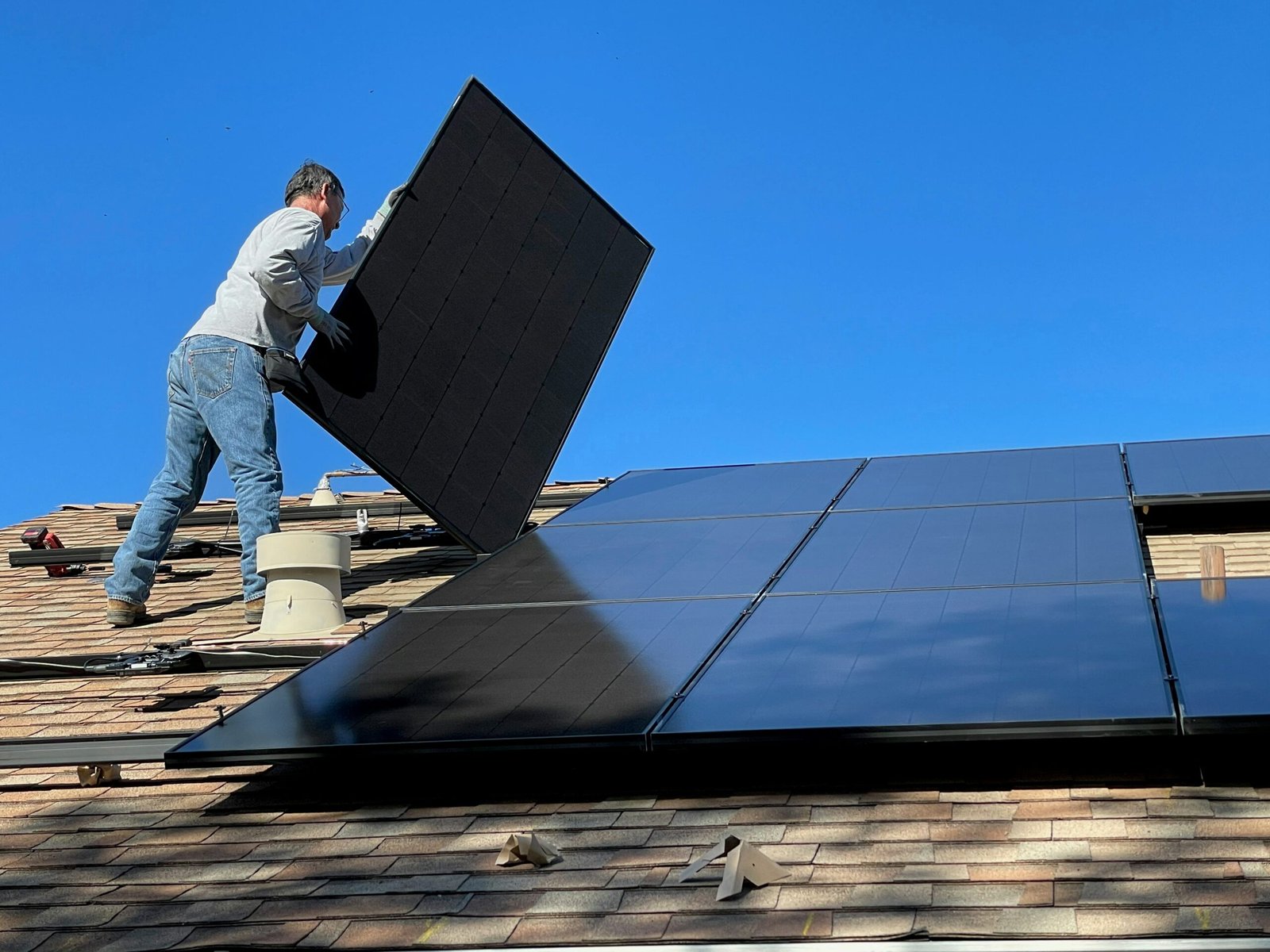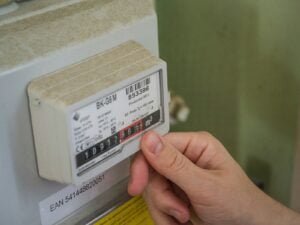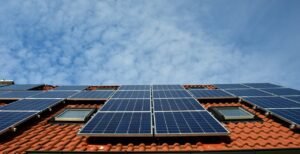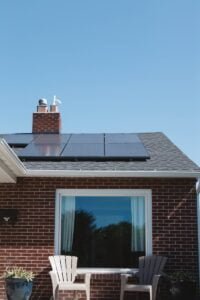Factors to Consider
Before calculating the number of solar panels needed for your home, it is important to consider several factors that can affect the efficiency and output of your solar system.
Energy Consumption: The amount of electricity you consume on a daily basis will play a significant role in determining the number of solar panels you need. To calculate your energy consumption, you can review your past electricity bills and identify your average daily usage. This will give you a baseline to work with and help you estimate the size of the solar system required to meet your needs.
Find number of ‘units’ consumed.
Roof Space: The available roof space is another crucial factor to consider when determining the number of solar panels. Ideally, you want to maximize the use of your roof area to ensure maximum energy production. Factors such as roof orientation, shading from nearby trees or buildings, and obstructions like chimneys or vents can impact the available space for solar panel installation.
Solar Panel Efficiency: The efficiency of solar panels has improved significantly over the years. Higher efficiency panels can generate more electricity with a smaller footprint. When selecting solar panels, it is important to consider the efficiency rating to ensure you get the most out of your system.
Calculating the Number of Solar Panels
Once you have considered the above factors, you can proceed to calculate the number of solar panels needed for your home. The formula for this calculation is relatively straightforward:
Number of Solar Panels = Total Energy Consumption / (Panel Efficiency × Average Daily Sunlight Hours)
The total energy consumption is the average daily usage you calculated earlier. The panel efficiency is the rating provided by the manufacturer, usually expressed as a percentage. The average daily sunlight hours can be obtained from local weather data or solar resource maps available online.
It is important to note that this calculation provides an estimate and may need to be adjusted based on other factors specific to your location and installation. Consulting with a solar professional can help ensure you have an accurate assessment of your solar panel requirements.
Step 2: Identify Energy-Intensive Appliances
Now that you have a clear understanding of your daily energy consumption, it’s time to identify the appliances in your home that are consuming the most energy. This step will help you pinpoint the areas where you can make the most significant energy savings.
Start by making a list of all the appliances in your home that require electricity. This includes major appliances such as refrigerators, air conditioners, water heaters, washers and dryers, as well as smaller appliances like televisions, computers, and kitchen appliances. Once you have the list, research the average energy consumption of each appliance. This information can usually be found in the user manual or online.
Next, calculate the energy consumption of each appliance on a daily basis. Multiply the average energy consumption (in kWh) by the number of hours the appliance is used each day. This will give you an estimate of how much energy each appliance is using on a daily basis.
Once you have identified the energy-intensive appliances in your home, you can start thinking about ways to reduce their energy consumption. This could include using energy-efficient models, adjusting settings to reduce energy usage, or even replacing old appliances with newer, more energy-efficient ones.
Step 3: Audit Your Home for Energy Efficiency
Now that you have a better understanding of your daily energy consumption and have identified the energy-intensive appliances in your home, it’s time to conduct an energy audit of your home. This step will help you identify areas where your home may be losing energy and provide you with recommendations on how to improve its energy efficiency.
Start by inspecting your home for air leaks. This could include gaps around windows and doors, as well as cracks in the walls or foundation. Seal any air leaks that you find using caulk or weatherstripping. This will help prevent drafts and keep your home more comfortable while reducing the need for heating or cooling.
Next, check your insulation levels. Insufficient insulation can result in significant energy loss. Inspect your attic, walls, and floors to ensure they are adequately insulated. If you find areas that lack insulation or have insufficient insulation, consider adding more to improve your home’s energy efficiency.
Additionally, evaluate your lighting. Replace traditional incandescent light bulbs with energy-efficient LED bulbs. LED bulbs use significantly less energy and last much longer, making them a cost-effective choice for lighting your home.
By conducting an energy audit of your home and making the necessary improvements, you can significantly reduce your energy consumption and save money on your electricity bills.
Step 3: Account for Seasonal Variation
When calculating your energy consumption, it is important to take into account the seasonal variation that occurs throughout the year. This is because your energy needs can fluctuate depending on the time of year and the weather conditions. For example, during the summer months, you may rely heavily on air conditioning to keep your home cool, resulting in higher electricity usage. On the other hand, during the winter months, you may need to use more electricity for heating purposes.
To accurately estimate your energy consumption, it is essential to consider the highest monthly usage you have experienced in the past. This will give you a baseline to work with and help you determine the maximum amount of energy you may need in any given month. However, it is also important to add a buffer to account for seasonal variation.
The buffer is necessary because even though you may have identified the highest monthly usage, it is possible that future months could require even more energy due to unforeseen circumstances. For instance, extreme weather conditions, such as heatwaves or cold snaps, can significantly impact your energy needs. By adding a buffer, you can ensure that you have enough energy to meet your requirements even during these exceptional periods.
It is recommended to consult historical data on energy consumption to get a better understanding of the seasonal variation in your area. This data can provide valuable insights into the patterns and trends of energy usage throughout the year. Additionally, you can also consider reaching out to energy experts or utility companies for guidance on estimating seasonal variation and determining an appropriate buffer.
By taking into account seasonal variation and adding a buffer to your energy consumption calculations, you can have a more accurate estimate of your energy needs. This will not only help you plan your energy usage more effectively but also ensure that you are prepared for any unexpected spikes in energy demand.
Once you have determined your average daily energy consumption, the next step is to calculate your monthly energy consumption. To do this, simply multiply your average daily consumption by 30. This will give you an estimate of the energy needed to power your home each month.
Calculating your monthly energy consumption is an important step in understanding your energy usage and managing your electricity bills. By knowing how much energy you are using on a monthly basis, you can make informed decisions about your energy consumption and take steps to reduce it if necessary.
Keep in mind that this calculation provides a rough estimate of your monthly energy consumption. Actual energy usage may vary depending on factors such as weather conditions, the number of occupants in your home, and the efficiency of your appliances and electronics.
It is also worth noting that your energy consumption may vary throughout the year. For example, during the summer months, you may use more energy for air conditioning, while in the winter months, heating may be the primary energy-consuming factor. By monitoring your monthly energy consumption over time, you can identify patterns and adjust your energy usage accordingly.
Understanding your monthly energy consumption is not only beneficial for managing your electricity bills, but it also plays a role in promoting energy efficiency and sustainability. By being aware of your energy usage, you can make conscious choices to reduce your environmental impact and contribute to a greener future.
Step 4: Determine Your System Size
Now that you have an estimate of your monthly energy consumption, you can determine the size of the solar system required. Solar systems are typically measured in kilowatts (kW). To calculate the system size, divide your monthly energy consumption by the average number of peak sun hours in your location.
Peak sun hours refer to the number of hours in a day when the sun’s intensity is at its highest. This is the time when solar panels can produce the most energy. The average number of peak sun hours varies depending on your location. For example, areas closer to the equator tend to have more peak sun hours compared to regions farther away.
To find the average number of peak sun hours in your location, you can refer to a solar insolation map or consult with a solar professional. These resources will provide you with valuable information about the solar potential of your area, taking into account factors such as weather patterns, shading, and the tilt and orientation of your roof.
Once you have determined the average number of peak sun hours, you can calculate the system size. Let’s say your monthly energy consumption is 1000 kWh, and the average number of peak sun hours in your location is 5 hours. Dividing 1000 kWh by 5 hours, you would need a solar system with a capacity of 200 kW to meet your energy needs.
It’s important to note that this calculation provides an estimate of the system size. Factors such as energy efficiency measures, future energy consumption changes, and shading should also be taken into consideration. Additionally, it’s recommended to consult with a solar professional who can conduct a detailed assessment of your energy needs and provide you with a more accurate system size recommendation.
Considerations for System Sizing
When determining the number of solar panels needed for your home, there are a few additional considerations to keep in mind:
- Energy Consumption: The first step in sizing your solar system is to understand your household’s energy consumption. This includes calculating the average daily energy usage, as well as peak usage during high-demand periods. By analyzing your energy consumption patterns, you can determine the size of the solar system needed to offset your electricity needs.
- Roof Space: The amount of available roof space is another crucial factor in system sizing. Solar panels are typically mounted on rooftops, so it’s essential to assess whether your roof has enough space to accommodate the desired number of panels. Factors such as shading from nearby buildings or trees should also be considered, as they can affect the efficiency of the solar panels.
- Solar Panel Efficiency: The efficiency of solar panels varies depending on the technology used. Higher efficiency panels can generate more electricity in a smaller area, which can be advantageous if you have limited roof space. However, higher efficiency panels often come with a higher price tag, so it’s important to strike a balance between efficiency and cost.
- Geographical Location: The amount of sunlight your location receives throughout the year plays a significant role in system sizing. Areas with more sun exposure will require fewer solar panels compared to regions with less sunlight. It’s essential to consider the average daily solar radiation in your area to accurately determine the number of panels needed to meet your energy requirements.
- Battery Storage: If you’re considering adding battery storage to your solar system, it’s crucial to account for this in the sizing process. Batteries allow you to store excess energy generated during the day for use during the night or when there’s limited sunlight. The number and capacity of batteries required will depend on your energy usage and the desired level of energy independence.
- Future Energy Needs: When sizing your solar system, it’s essential to consider your future energy needs. If you anticipate an increase in electricity consumption due to factors such as expanding your household or adding electric vehicles, it’s advisable to size your system accordingly. This will ensure that your solar system can continue to meet your energy needs in the long run.
By taking these considerations into account, you can determine the optimal size for your solar system, ensuring that it meets your energy requirements while maximizing efficiency and cost-effectiveness.
Roof Space
The amount of available roof space will play a significant role in determining the number of solar panels you can install. If you have limited roof space, you may need to consider higher efficiency panels or alternative installation options such as ground-mounted systems.
When assessing the available roof space, it is important to take into account any obstructions such as chimneys, skylights, or ventilation systems. These can limit the amount of usable space for solar panels. Additionally, the orientation and tilt of the roof will also impact the efficiency of the panels.
In cases where the roof space is limited, opting for higher efficiency panels can be a viable solution. These panels are designed to convert a higher percentage of sunlight into electricity, allowing you to generate more power with fewer panels. While higher efficiency panels may come at a higher cost, they can be a worthwhile investment in situations where space is a constraint.
Alternatively, if your property has ample land available, you may consider installing a ground-mounted solar system. This involves placing the solar panels on a structure built on the ground, rather than on the roof. Ground-mounted systems offer flexibility in terms of panel orientation and tilt, allowing for optimal sunlight exposure. However, it is important to consider the additional costs associated with ground-mounted systems, such as the construction of the support structure and potential land use restrictions.
Before making a decision on the installation options, it is recommended to consult with a solar energy professional. They can assess your property, take into account your energy needs, and provide expert advice on the most suitable system for your specific situation. By considering factors such as available roof space, obstructions, and alternative installation options, you can make an informed choice that maximizes the efficiency and effectiveness of your solar power system.
Panel Efficiency
The efficiency of solar panels has improved over the years, allowing for higher energy production in a smaller footprint. Higher efficiency panels can generate more electricity per square meter, reducing the number of panels needed to meet your energy needs.
With advancements in technology and manufacturing processes, solar panel efficiency has significantly increased. In the early days of solar energy, panels had an efficiency of around 10-15%. This meant that only a small percentage of sunlight was converted into usable electricity. However, modern solar panels now boast efficiencies of 20% or even higher.
One of the main factors contributing to improved panel efficiency is the development of new materials and technologies. Traditional solar panels are made from silicon, which is a relatively inexpensive and widely available material. However, silicon-based panels have limitations in terms of efficiency. To overcome this, researchers have been exploring alternative materials such as thin-film solar cells.
Thin-film solar cells are made from a variety of materials, including cadmium telluride (CdTe), copper indium gallium selenide (CIGS), and amorphous silicon (a-Si). These materials have different properties that allow for higher efficiency and lower manufacturing costs. For example, CdTe solar cells have achieved efficiencies of over 22%, making them competitive with silicon-based panels.
Another factor contributing to increased efficiency is the improvement in cell design. Solar cells are made up of multiple layers, each performing a specific function in the conversion of sunlight into electricity. By optimizing the design of these layers, researchers have been able to enhance the overall efficiency of the panel.
In addition to material advancements and cell design, improvements in manufacturing processes have also played a role in increasing panel efficiency. Manufacturers have implemented more precise techniques for depositing thin films and creating electrical contacts, resulting in higher quality panels with improved performance.
The benefits of higher panel efficiency are significant. Firstly, it means that you can generate more electricity from the same amount of sunlight. This is particularly important in areas with limited space for solar installations. With higher efficiency panels, you can produce more power per square meter, maximizing the energy output from your available space.
Moreover, increased panel efficiency translates to a higher return on investment. Since you can generate more electricity with fewer panels, the overall cost of your solar energy system decreases. This makes solar power more accessible and economically viable for a wider range of consumers.
In conclusion, the efficiency of solar panels has come a long way, thanks to advancements in materials, cell design, and manufacturing processes. Higher efficiency panels offer numerous benefits, including increased energy production, reduced installation space requirements, and improved return on investment. As technology continues to evolve, we can expect even greater efficiency gains in the future, making solar energy an increasingly attractive option for powering our homes and businesses.
Additionally, it is worth considering the long-term financial benefits of solar panels. Installing a solar panel system can increase the value of your home and make it more attractive to potential buyers in the future. This can be a significant advantage if you plan to sell your property down the line.
While it is important to consider the technical aspects of solar panel systems, such as the number of panels needed, it is equally crucial to assess your budget and financial goals. By striking a balance between system size and cost, evaluating the potential ROI, exploring financing options, and considering long-term benefits, you can make an informed decision that aligns with your financial situation and goals.








